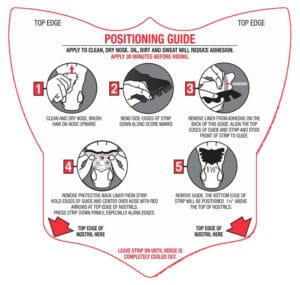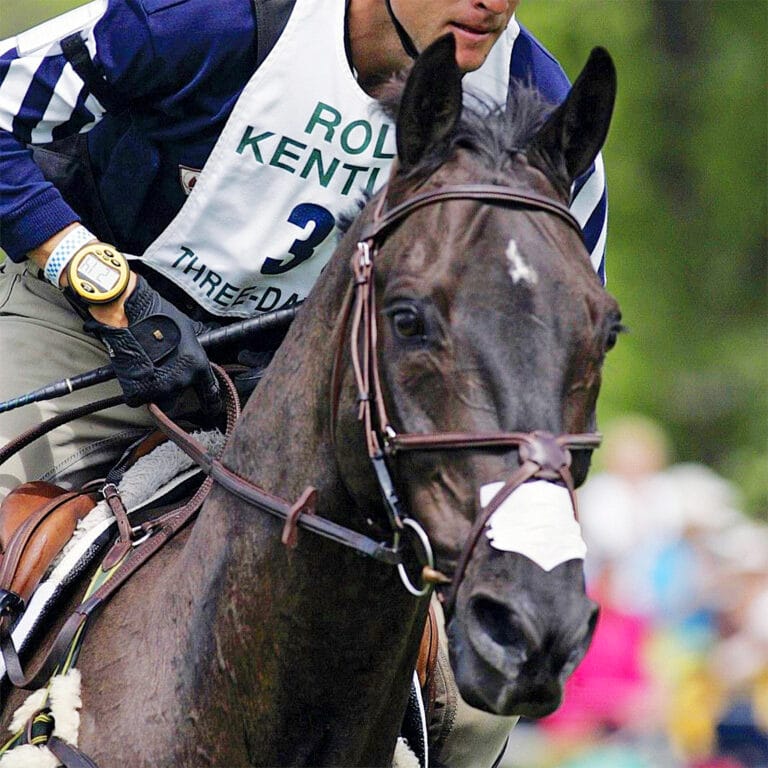Horses require large quantities of oxygen for optimum performance. JESSICA MORTON explores a clever solution to those all too frequent breathing problems.
Studies have shown up to 80 per cent of horses suffer from respiratory disease, often significantly impacting their performance and quality of life. Fortunately, a pair of forward-thinking veterinarians studying Exercise Induced Pulmonary Haemorrhage (EIPH) in racehorses came up with Flair Equine Nasal Strips – a drugless solution to breathing problems that has allowed many horses to successfully return to competition.
Eventer and Olympian Andrew Hoy has been using nasal strips for more than a decade, declaring that they are an important part of his multifaceted “horse management jigsaw puzzle”, a puzzle in which all the parts work together to allow his horses to stay mentally and physically healthy and perform at their best.

A delicate balance
You probably know that unlike humans, a horse breathes entirely through their nose. But did you know how delicate this breathing mechanism is?
When a horse inhales, oxygen is drawn in through the nostrils, along the nasal passage, and down into the lungs. The soft tissue over the nasal passage is also sucked in as they breathe, reducing the diameter of the airway and restricting airflow.
The sticky solution
Flair Nasal Strips are designed to help maximise a horse’s oxygen intake by helping to keep the upper airway open. The stretchy, sticky, one-use strips are applied to the skin above the horse’s nostrils to support the nasal passage, helping to reduce soft tissue collapse, and thereby decreasing the effort needed to move air in and out of the lungs. This results in less stress on the body during exercise and faster recovery after exercise.
Essentially, the strip ‘tents’ the skin on the nose over the nasal valve (the narrowest point in the nasal cavity and a major contributor to nasal resistance), helping to keep the nasal passage dilated and facilitating easier breathing during exercise. The concept is remarkably simple but over the past twenty years has been backed up by university and clinical studies. Popular amongst barrel racers, polo players and eventers, research as well as anecdotal evidence has shown that nasal strips improve airflow into the horse’s lungs, resulting in:
· enhanced performance
· faster recovery
· reduced incidence of EIPH

Flair Equine Nasal Strips are available in a variety of colours.
A closer look at EIPH
EIPH can easily go undetected because it happens deep within the lungs. Studies show that all horses experience some degree of EIPH during intensive exercise, but only five per cent will have blood in their nostrils. Each incidence of lung bleeding contributes to the formation of scar tissue, which may limit performance and cause long-term irreversible lung damage.
Researchers in Japan found that horses do not have to gallop to bleed. Thoroughbreds cantering at slow speeds all showed damage to their lungs because of broken blood vessels, and in later studies it was reported that lung bleeding can even occur at slower gaits.
A complex system
The horse’s respiratory system is their Achilles heel, and even a small amount of inflammation or obstruction can influence speed, balance and recovery times. Equine breathing differs from that of other species especially at speed, where there is a correlation between step and respiratory rates.
When a horse starts cantering or galloping, as the first forelimb hits the ground the rib cage is pulled forward activating inhalation. Then in the weight-bearing phase, the horse is pushed to exhale. The coupling of stride to breathing rate is an issue for breeds like the Quarter Horse, which has a frequency rate of over three strides per second.
If a normal horse typically inhales and exhales once per stride, this means Quarter Horses are breathing in and out over three times per second, putting immense pressure on their respiratory and muscular systems.
When a horse cannot deliver enough oxygen to the lungs, their muscles are inadequately fuelled. Additional pressure on the respiratory system ruptures the membrane separating the alveoli from the blood vessels in the lungs, resulting in the haemorrhaging known as EIPH.
Outside of racing, it is believed that the prevalence of horses that suffer with EIPH in barrel racing is 45 per cent; polo at 30 per cent and eventing at 13 per cent.
Pioneering research
Kansas University Professor Howard Erickson, a former veterinary heart specialist with the United States Air Force, and his colleague Dr David Poole pioneered the development of equine nasal strip to support horses suffering from EIPH, helping to reduce the severity of the condition by decreasing stress on the respiratory system.
After initially testing the nasal strip on Thoroughbred racehorses, the researchers found that they suffered less lung damage and bleeding. Since then, scientific studies have shown that the nasal strip can decrease EIPH by approximately 50 per cent, with the additional benefit of a reduction in the secondary infections that can occur after a bleed.
So if your horse is experiencing decreased airflow for any reason, a nasal strip might be just the thing to give them some relief, and you some peace of mind.



